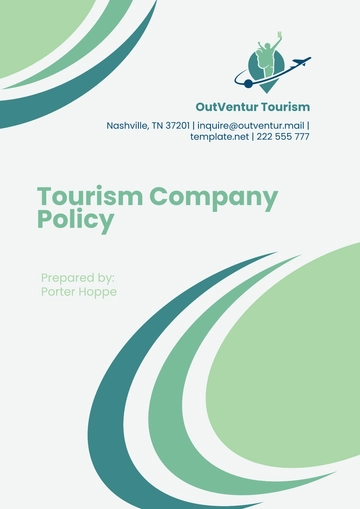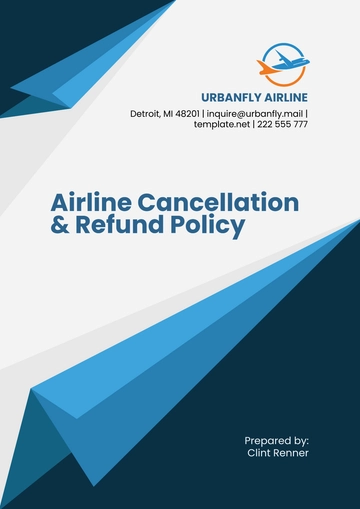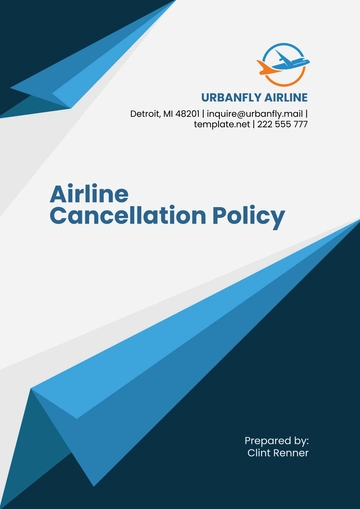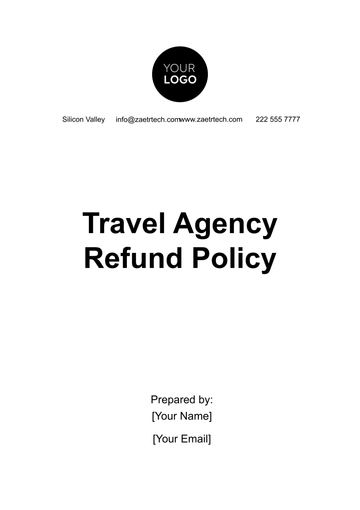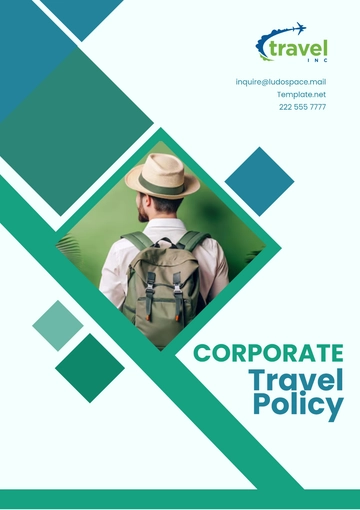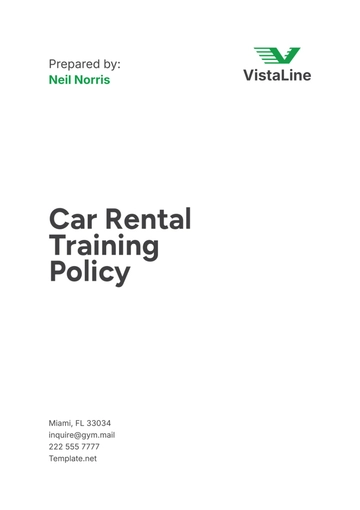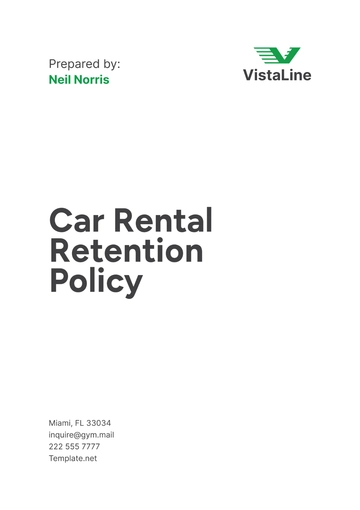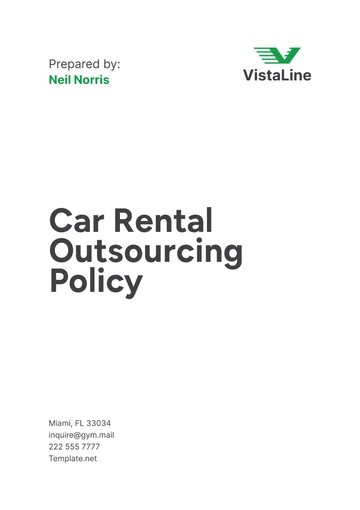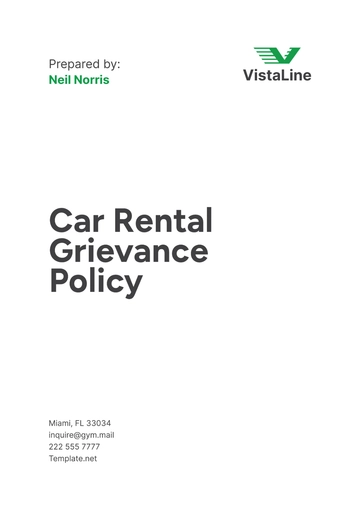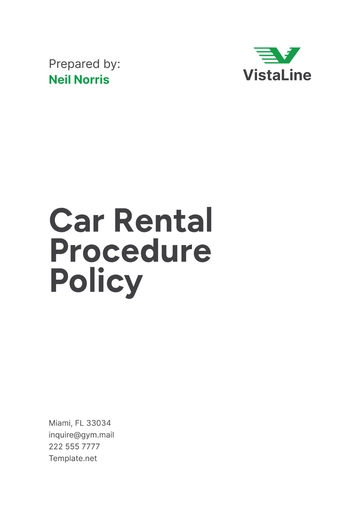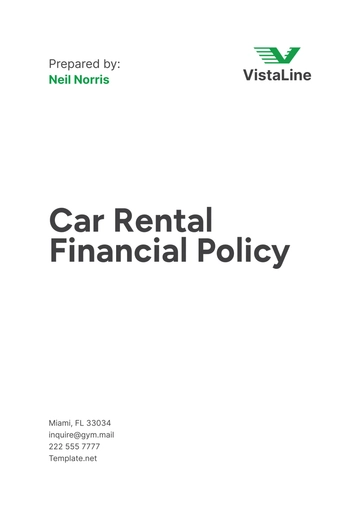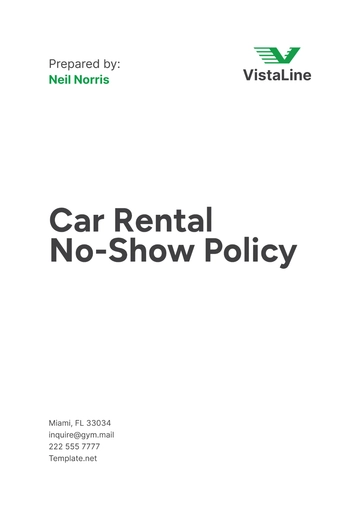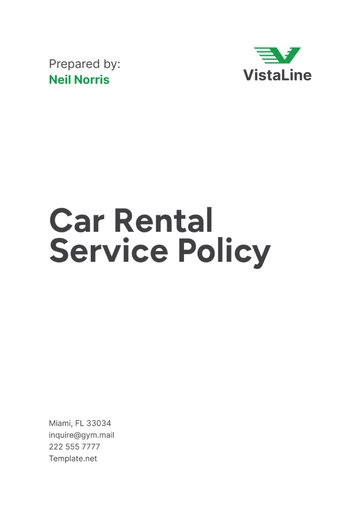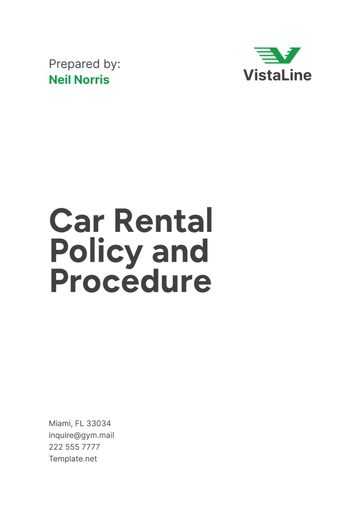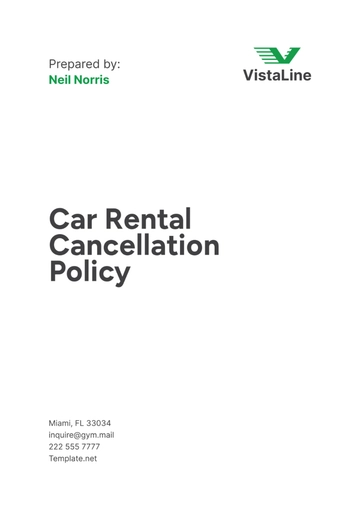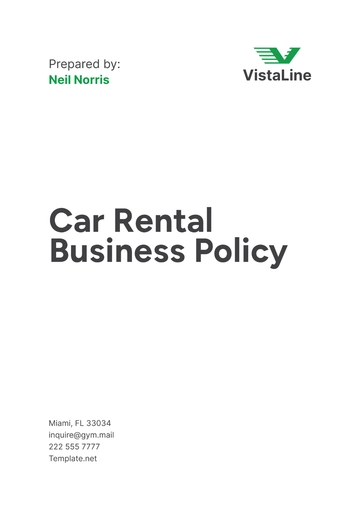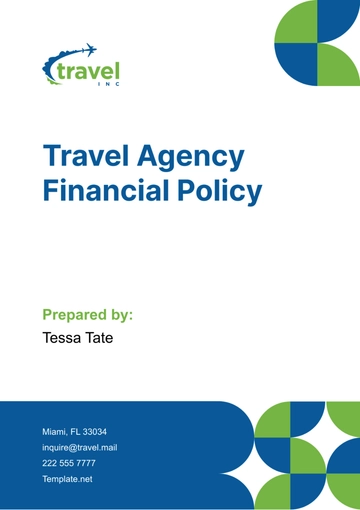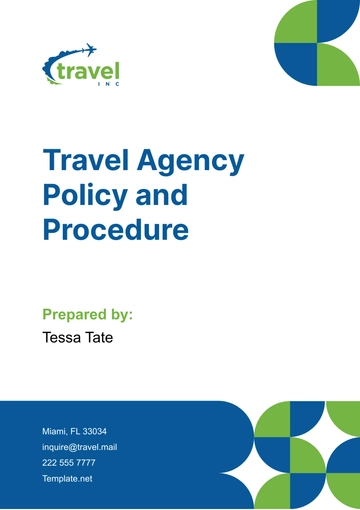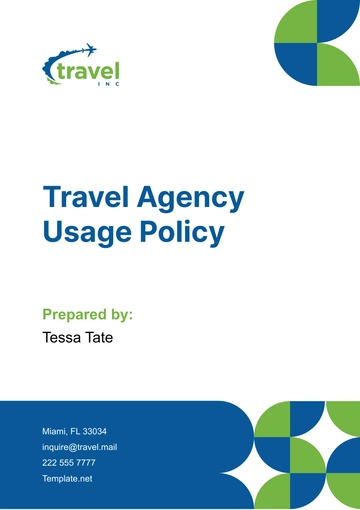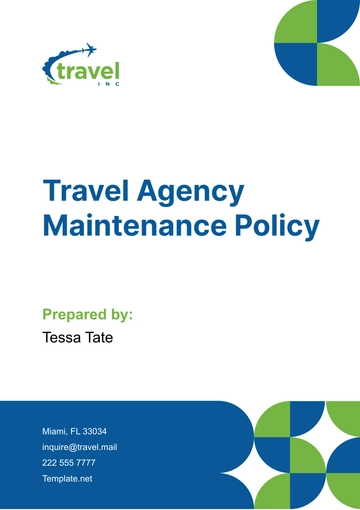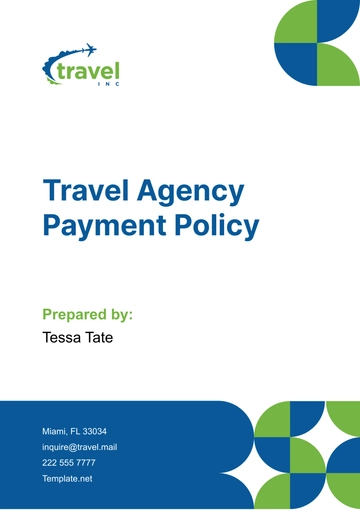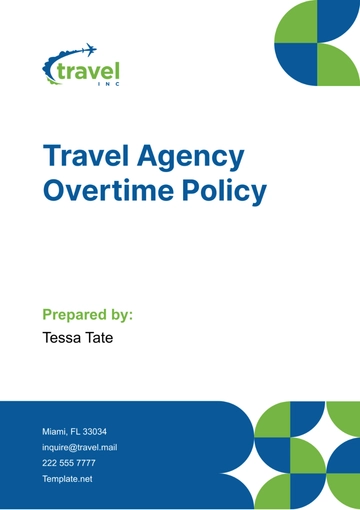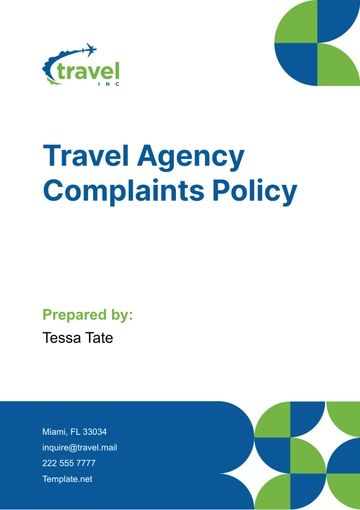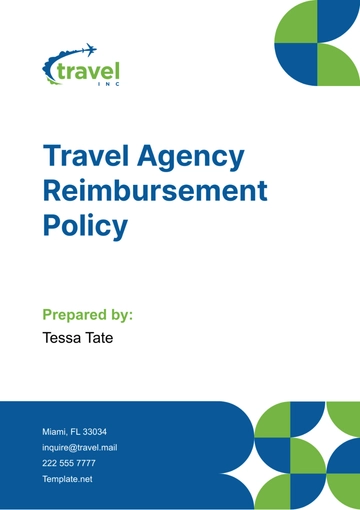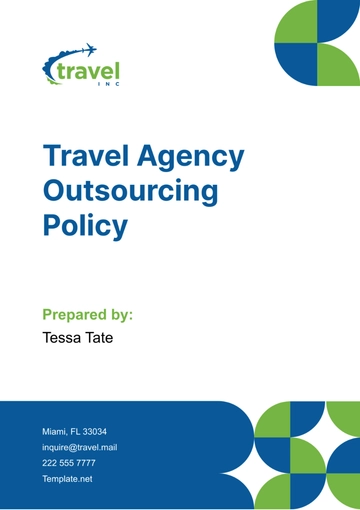Free Travel Agency Safety Policy
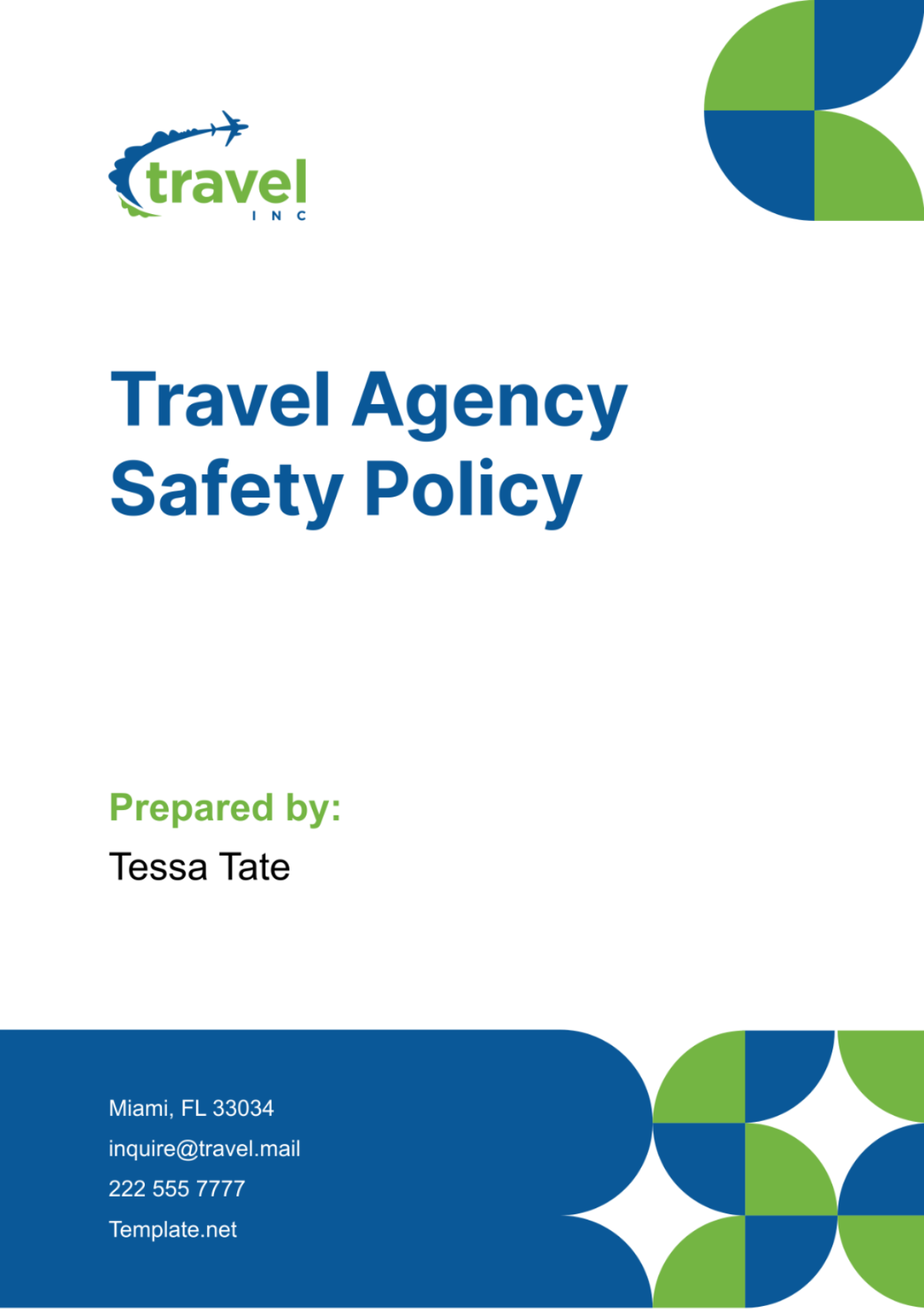
1. Introduction
Purpose of the Policy
This policy is designed to ensure the safety and well-being of all clients and staff engaged with travel services provided by [Your Company Name]. The document sets forth the company's commitment to maintaining high safety standards, mitigating risks, and responding effectively to various travel-related emergencies.
Scope
This policy applies to all employees, contractors, and clients of [Your Company Name]. It covers all aspects of travel services, including planning, booking,
travel support, and post-trip follow-up.
2. Responsibilities
Management's Responsibilities
Develop, implement, and continuously update the comprehensive safety policy, ensuring it aligns with international safety standards and best practices.
Allocate appropriate resources to support the enforcement of safety measures, including technological tools, training programs, and expert consultations.
Conduct regular safety audits and risk assessments to identify potential areas of improvement and ensure compliance with safety regulations.
Employees' Responsibilities
Familiarize themselves thoroughly with all aspects of the safety policies and procedures pertinent to their roles.
Attend all mandatory safety training sessions and drills, and apply the learned practices in their daily operations.
Actively monitor and immediately report any deviations from the safety protocols or any potential hazards they might encounter in their work environment or during travel operations.
Traveler's Responsibilities
Comply with all the travel safety advice and directives provided by [Your Company Name], including adhering to recommended health precautions and behavior conduct in different cultural contexts.
Inform the agency of any personal circumstances or health issues that may affect their travel safety.
Remain vigilant and proactive in personal safety practices while traveling, including maintaining regular communication with [Your Company Name] during their trip.
3. Risk Assessment
Identifying Potential Risks
Systematically review each travel destination’s political stability, healthcare standards, environmental conditions, and overall safety for tourists. This includes tracking travel advisories issued by governments and international bodies.
Evaluate transportation options for each segment of a journey, considering factors such as vehicle maintenance records, driver training, and safety certifications of transportation providers.
Analyzing and Prioritizing Risks
Use a formalized risk matrix to categorize and prioritize risks, allowing for a clear visualization of potential impacts versus the likelihood of occurrence. This matrix helps in focusing resources on mitigating high-probability, high-impact risks.
Engage in scenario planning exercises to prepare for a variety of potential emergencies or disruptions, enabling proactive strategy development rather than reactive responses.
Implementing Preventative Measures
Establish strict vendor selection criteria that prioritize safety, including mandatory safety certifications and positive safety track records. Regularly review and renew these criteria based on emerging trends and technologies in travel safety.
Develop comprehensive pre-travel training packages for travelers, which include destination-specific safety briefings, health advice, and cultural etiquette.
4. Travel Planning and Booking
Selection of Safe Travel Options
Implement a multi-tiered evaluation system for all travel-related service providers, focusing on their adherence to international safety standards, the robustness of their emergency response protocols, and the quality of their training programs.
Regularly update travel planning protocols to integrate real-time safety intelligence, adjusting travel recommendations based on current events and threat levels.
Accommodation Safety Standards
Maintain a preferred partner list that exclusively includes accommodations that have passed rigorous safety inspections, which assess factors from fire safety measures to food hygiene practices.
Conduct biannual reviews of these accommodations to ensure ongoing compliance and address any new safety issues that may arise, including environmental changes and upgrades in local infrastructure.
Transportation Safety Standards
Regularly review and update criteria for selecting transportation providers, including audits of vehicle conditions, driver qualifications, and compliance with international safety norms.
Provide travelers with transparent access to safety assessments of recommended transportation options, encouraging informed decision-making.
5. Health and Medical Precautions
Required Vaccinations and Health Advisories
Establish partnerships with health organizations to provide up-to-date information on health risks and vaccination requirements for each destination. This includes alerts about outbreaks and health warnings.
Offer personalized health advisory sessions for travelers, especially for those visiting high-risk areas or with specific health vulnerabilities.
Medical Kit and Health Resources
Provide a comprehensive checklist of recommended items for a personal medical kit, tailored to the destination and length of stay. This includes medications, first aid supplies, and emergency health information.
Develop guidelines for the construction and use of these medical kits, including instructions on basic first aid procedures and the safe storage of medications.
Guidelines for Traveling with Pre-existing Medical Conditions
Create a detailed process for clients to confidentially disclose any pre-existing conditions, allowing for personalized travel planning that takes these conditions into account.
Collaborate with healthcare providers to develop travel plans that ensure continuity of care, access to necessary medications, and the availability of medical services during the trip.
6. Safety Training and Awareness
Regular Training Programs for Staff
Design and implement a comprehensive safety training curriculum for all employees, which includes annual refresher courses, emergency response drills, and training on new safety technologies and procedures.
Evaluate the effectiveness of training programs through tests and drills, refining them based on feedback and the evolving nature of travel risks.
Pre-trip Safety Briefings for Travelers
Offer detailed pre-trip briefings that cover everything from health and safety risks to local laws and customs, delivered through multiple formats such as online webinars, printed guides, and personal consultations.
Encourage interactive engagement during these briefings to address specific concerns and scenarios that travelers may face, ensuring they are well-prepared and confident.
Access to Real-Time Safety Information
Utilize advanced travel technology platforms to provide travelers with real-time updates on safety conditions, including political disturbances, weather-related disruptions, and health alerts.
Establish a dedicated 24/7 communication line that travelers can contact for immediate access to safety information and support while abroad.
7. Emergency Procedures
Emergency Contact Information
Detailed and easily accessible contact information for various emergency services, including local embassies, consulates, and specialized emergency response teams, categorized by country and type of emergency.
Steps for Handling Different Types of Emergencies
Develop specific action plans for a range of potential emergencies, such as medical incidents, natural disasters, or political unrest. Each plan includes step-by-step instructions tailored to the nature of the emergency and the location.
Train all staff in these procedures and regularly review and practice them to ensure efficiency and effectiveness.
Evacuation Procedures
Outline clear evacuation protocols for different scenarios, including assembly points, primary and secondary evacuation routes, and methods of transportation.
Coordinate with local authorities and emergency services in various destinations to support efficient evacuation processes and ensure that all staff and travelers can access these protocols easily.
8. Travel Insurance
Insurance Coverage Requirements
Define a set of minimum insurance requirements for all travelers, covering areas such as medical expenses, trip cancellation, lost luggage, and emergency repatriation.
Educate travelers about the importance of adequate insurance coverage and the potential risks of traveling without it.
Assistance in Acquiring Travel Insurance
Facilitate the insurance purchasing process by recommending trusted insurance providers and assisting travelers in understanding and selecting the appropriate coverage options for their specific needs.
Provide a direct liaison between travelers and insurance providers to simplify the claims process and ensure that travelers receive the support they need in case of an incident.
Handling of Insurance Claims
Offer comprehensive support in managing insurance claims, from initial filing to final resolution. This includes providing necessary documentation, liaising with insurance providers, and advocating on behalf of the traveler to ensure fair treatment and swift processing of claims.
9. Data Security and Privacy
Category | Details |
|---|---|
Protection of Personal Information | Compliance with international data protection laws such as GDPR. Regular audits and updates to security protocols to ensure the integrity and confidentiality of personal data. Training for all employees on data protection best practices and security measures. |
Secure Handling of Financial Transactions | Implementation of encryption technologies and secure payment systems to protect financial data and transactions. Regular security reviews and updates to ensure adherence to the latest security standards and technologies. |
10. Crisis Management
Category | Details |
|---|---|
Crisis Management Team and Contact Points | Establishment of a specialized crisis management team available 24/7. Clear, accessible contact information for the team, ensuring rapid communication during a crisis. |
Crisis Communication Plan | A comprehensive strategy including predefined communication channels and templates for timely updates to travelers, staff, and external stakeholders. Regular drills and updates to keep the communication plan effective. |
Post-Crisis Evaluation and Feedback | A systematic approach for evaluating the handling of crises, including debriefing sessions and mechanisms for feedback from all participants. Insights gained are used to refine and strengthen future crisis management plans. |
11. Monitoring and Review
Category | Details |
|---|---|
Regular Policy Reviews | Annual meetings to evaluate the safety policy's effectiveness, incorporating new safety information and technological advancements. Involvement of external consultants for unbiased feedback. |
Updating Procedures and Practices | Continuous integration of new safety technologies and methods. Adjustments in procedures to reflect legal and best practice changes, ensuring up-to-date compliance. |
Feedback Mechanism from Staff and Travelers | Robust feedback systems, including surveys and online forums, ensure anonymity and confidentiality. This feedback is used to make ongoing improvements in safety practices. |
12. Policy Enforcement
Disciplinary Actions for Non-compliance
Clearly define and communicate the consequences of non-compliance with safety policies, applying these penalties consistently and fairly across the organization.
Provide a graduated scale of disciplinary actions, from warnings to termination, depending on the severity and frequency of the infractions.
Reporting Mechanisms for Safety Concerns
Create easy-to-use, accessible tools for reporting safety concerns, ensuring that employees and travelers can report issues without fear of reprisal.
Establish a follow-up protocol to investigate reported concerns promptly and thoroughly, maintaining transparency in the handling of such reports.
Continuous Improvement Strategies
Implement regular training updates, policy revisions, and technology enhancements to continuously improve safety standards.
Encourage a proactive approach to safety, rewarding employees and travelers for exemplary safety practices and innovative ideas that enhance overall safety.
- 100% Customizable, free editor
- Access 1 Million+ Templates, photo’s & graphics
- Download or share as a template
- Click and replace photos, graphics, text, backgrounds
- Resize, crop, AI write & more
- Access advanced editor
Enhance safety standards with Template.net's Travel Agency Safety Policy Template. This customizable and editable resource is perfectly compatible with the Ai Editor Tool, allowing you to develop specific safety protocols tailored to your agency's needs. Secure a safer working environment with our professionally designed template, ensuring comprehensive safety management and compliance.
You may also like
- HR Policy
- Restaurant Policy
- Company Policy
- Accounting Policies and Procedures
- Website Policy
- Privacy Policy
- Safety Policy
- School Policy
- IT and Software Policy
- Law Firm Policy
- Construction Policy
- Interior Design Policy
- Travel Agency Policy
- Education Academic Policy
- Security Policy
- Real Estate Policy
- Expense Policy
- Software Policy
